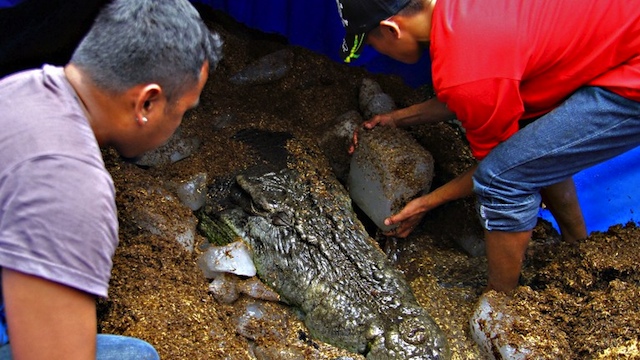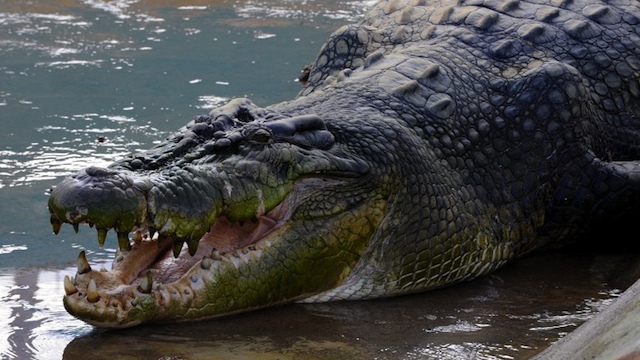SUMMARY
This is AI generated summarization, which may have errors. For context, always refer to the full article.

MANILA, Philippines (UPDATED) – The Department of Environment and Natural Resources (DENR) sent on Monday, February 11 a team of investigators to Bunawan, Agusan del Sur to look into the death of Lolong, the world’s largest crocodile in captivity until it passed away on Sunday night.
The team will be composed of representatives from the Protected Areas and Wildlife Bureau (PAWB) and the National Museum to assist in preserving the reptile’s skin, DENR Secretary Ramon Paje said in a statement.
Paje explained that the experts “will help ensure that the necropsy (autopsy performed on a nun-human body) would be carried out in a manner that would make it possible to contribute Lolong’s remains to taxidermy,” Paje said.
The PAWB, he added, is coordinating with Bunawan Mayor Edwin Elorde and the National Geographic Channel, whose crocodile specialist Dr. Adam Britton measured Lolong at 6.17 m (20.24 feet).
Guinness World Records in May 2012 officially recognized the reptile as the largest living crocodile in captivity, beating Cassius, a 5.48 m specimen kept in a park on an island off Australia’s Queensland, as the previous record holder.
Paje said Lolong’s death is a significant loss to the crocodile conservation program, for which Lolong was considered an “ambassador.”

Cause of death unclear
Scores of citizens, among them influential forensic pathologist Dr. Raquel Fortun, have called for an official probe into the cause of death of the most famous reptile in the country.
The Philippine Star reported on Monday that Lolong had been ailing since swallowing a cord 3 weeks ago, but Bunawan spokeswoman Welinda Elorde denied the claim.
“We have been alternately feeding him with meat and poultry, and there was no way he could have eaten anything other than that,” she told AFP.
The reptile had not eaten its usual meal late last month, and its left stomach “ballooned,” a municipal official told the Philippine Daily Inquirer on Sunday, February 10.
A government-sanctioned hunting party caught Lolong in a sprawling marsh close to Bunawan in September 2011 after it was suspected of biting the head off a young school girl and of eating a fisherman.
Its capture made the town famous and Lolong, named after a local crocodile hunter, became a big tourist attraction.
Lolong belonged to the species Crocodylus Porosus, or the Indo-Pacific crocodile, the world’s largest reptile, which experts say can live up to a century.
While not on the brink of extinction globally, it is critically endangered in the Philippines, where it is hunted for its hide.

Lolong suffered in captivity – PETA
Lolong also put the spotlight on the plight of the crocodiles in the Philippines’ remote marshes and rivers, as human habitation increasingly put them in conflict with the animals.
Animal rights groups demanded that the reptile be released back into the wild, arguing that the pen that held him was too small and stressful for an animal used to roaming great distances.
Elorde however insisted that caretakers tried to give Lolong everything he needed in captivity, and that releasing him would have left him in the mercy of villagers who would hunt and kill him.
“We tried to give him the best place we could,” she said.
People for the Ethical Treatment of Animals (PETA) on Monday stressed that “the death of Lolong is tragic but, sadly, not surprising.”
“While the exact cause of Lolong’s death is still being investigated, scientific studies have shown that captive animals die younger than their wild counterparts. Lolong suffered and died because people wanted to make money off his captivity,” the animal rights group said in a statement.
PETA added that “no zoo can come close to providing what even small crocodiles need, much less a crocodile [this] size.”
“When you consider the immense size and strength of Lolong, there is no doubt that being contained in a cramped enclosure caused him extreme distress and misery,” the statement said.
Aussie croc back on top
After Lolong’s death, Cassius has now reclaimed the crown of the world’s largest crocodile in captivity.
Captured in Australia’s Northern Territory in 1987, Cassius is named after the legendary boxer Cassius Clay, better known as Muhammad Ali, and has lived at the Marineland Melanesia crocodile park on Green Island, Queensland, for the past 26 years.
George Craig, the animal’s owner and keeper since the reptile arrived in Cairns in 1987, said he was sad to hear the Philippine croc died.
“I’m actually a little bit upset the damn thing conked out,” he told The Cairns Post on Monday.
Craig explained that Lolong “was a very big reptile, but he was pretty young looking, so he could have grown a little bit bigger.”
“He might outlive us all,” he said.
Like Lolong in Agusan del Sur, Cassius is a celebrity in Cairns, and despite being over 100 years old is still healthy and has all his teeth.
A video about the crocodile posted a year ago on has been viewed by over 2 million people on YouTube. – with reports from Agence France-Presse/Rappler.com
Related stories:
Add a comment
How does this make you feel?
![[ANALYSIS] A new advocacy in race to financial literacy](https://www.rappler.com/tachyon/2024/04/advocacy-race-financial-literacy-April-19-2024.jpg?resize=257%2C257&crop_strategy=attention)


![[In This Economy] Can the PH become an upper-middle income country within this lifetime?](https://www.rappler.com/tachyon/2024/04/tl-ph-upper-income-country-04052024.jpg?resize=257%2C257&crop=295px%2C0px%2C720px%2C720px)

There are no comments yet. Add your comment to start the conversation.